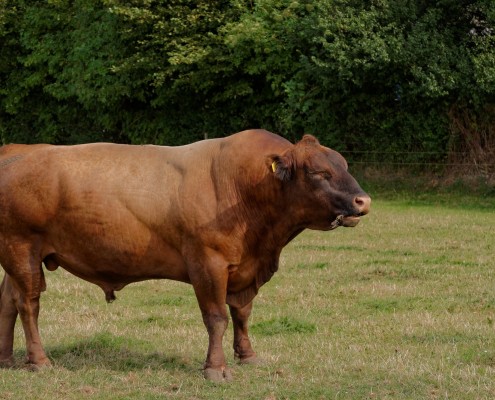Breed descreption Angus
Color: Unicolored red or black.
Horns:This breed is genetically hornless
Body Structure:
Angus Cattle are a medium-framed beef cattle. They have a long body structure with low ribs. Shoulder and back are wide and well-muscled. The pelvis is long, wide and slightly tilted, which provides best conditions for easy calving. The form of the leg muscles is low and wide with well-muscled inner legs. Angus cattle characteristically have a light, short head, fine bone structure, very correct limbs, as well as short, firm hooves. The firm udders with short, easily suckle-able tits make for a long working life.
Product Characteristics:
Their calm character makes the handling of these animals very easy. Due to their low ribs and strong rump, they are extremely suitable for pasture, a trait that makes this breed popular world-wide. Even on bad pasture, these animals promise a high market performance. Due to their early maturity, Angus cattle can be served for the first time at 15 months; the first calving therefore happens at 2 years without any complications. With their third calf, the cows reach their final weight.
The good milk yield of the cows make a suckling period of 9 months possible, resulting in an excellent weaning weight of the calves. Their excellent capacity for roughage, their easy handling, and the great performance of the animals reared for slaughter are the reason for the high market performance of the Angus cattle.
If the valuable parts on the carcass are well-structured, the genetic superiority of these animals can be seen in the tenderness and marbling of the meat.
Basic Information about bulls and cows:
| Dimensions and weights | cows | bulls |
| Height of the sacrum (cm) | approx. 136 | approx.um 145 |
| Weight (kg) | approx. 700 | approx. 1.100 |
| Birth Weight (kg) | 32 | 35 |
| 200-days-Weight (kg) | 210 | 240 |
| 365-days-Weight (kg) | 340 | 400 |
| daily increase young bulls (g) | – | 1.185 |
Breeding Goals
The defined color, as detailed in the race description, is binding. White pigments are undesirable and are only acceptable along the abdominal line from the navel to the udder, on the udder, or, for bulls, behind the prepuce. Animals with diverging white markings are graded with a mark 4. Any kind of deviation from the genetic hornless status, e.g. scurs result in a mark 4.
For the exterior evaluation, the definitions of the race description are to be applied unconditionally. If the rump is evenly wide, tight transitions and harmonious proportions are particularly important. Apart from the correct form and posture of the limbs and hooves, flawless movement is of particular importance.
A good muscle structure is particularly important for back, shoulder and leg. The excellent milk yield and motherliness of the Angus cow, along with the regular calving of living calves, make for an excellent breeding performance and a long working life. Severe defects of the udder, such as tits unfit for suckling or a low hanging udder, are graded with the mark 4.
Animals, who correspond to the genotype AA are specially documented.
Source of the text: FRZ e.V, Kiel
Link to the Federal Association Rind und Schwein e.V. (BRS)
